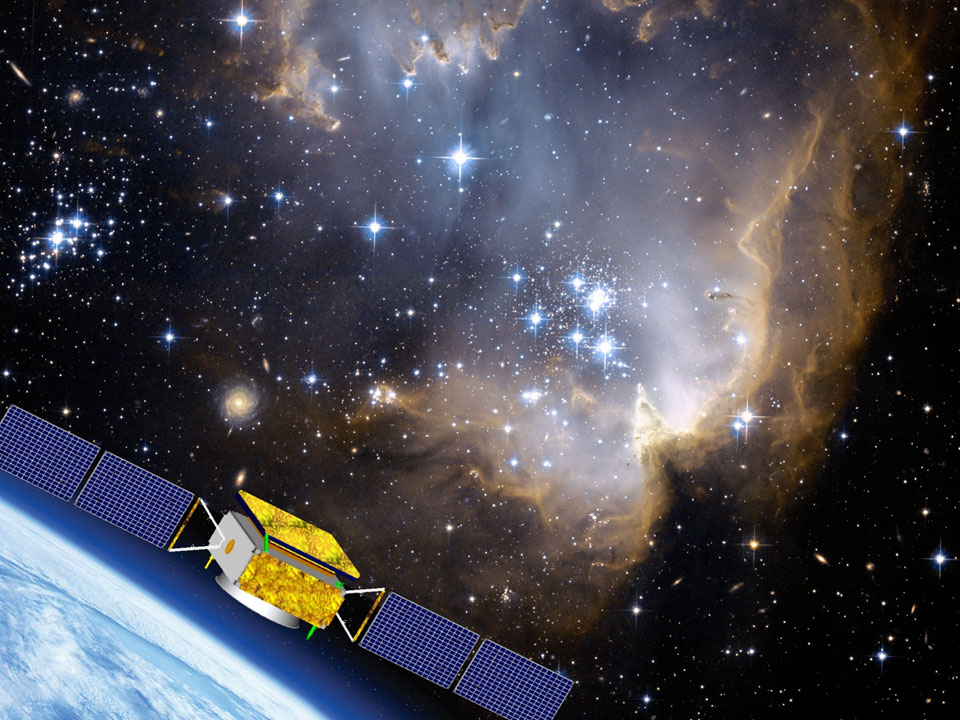China's Cosmic 'Monkey King' Satellite Looks for Dark Matter

By analyzing cosmic rays in space, China's "Monkey King" satellite is now helping pin down the identity of dark matter, a new study finds.
The Dark Matter Particle Explorer (DAMPE) satellite, launched in 2015, is China's first space observatory. DAMPE's aim is to help find the origins of dark matter — the mysterious, invisible substance that researchers suspect makes up about five-sixths of all matter in the universe.
DAMPE is nicknamed "Wukong" after Sun Wukong, the Monkey King, the mischievous, shape-shifting hero of the epic Chinese tale "Journey to the West." "Wu" means "understanding" and "kong" means "void," so Wukong can also mean "understanding the void" — hence, the name underscores DAMPE's mission to help scientists understand dark matter. [The Search for Dark Matter in Images]
DAMPE is specifically designed to detect the highest-energy beams of light, known as gamma rays, as well as cosmic rays. The latter are particles that zip through outer space with extraordinarily high amounts of energy. Many cosmic rays are composed of the nuclei of atoms, but some are electrons, while others are the positively charged antimatter counterparts of electrons known as positrons.
Some models of dark matter suggest that it can break down into cosmic rays — specifically, pairs of electrons and positrons. When these positrons hit electrons, they annihilate each other, releasing gamma rays. However, there are many other potential sources of cosmic rays and gamma rays, such as pulsars — which are rapidly whirling collapsed stars — or supernova remnants, which are debris from stars that died in catastrophic explosions. DAMPE measures the amount of energy in gamma rays and cosmic rays to help shed light on what their sources are.
Previous balloon- or space-borne experiments analyzing cosmic rays only directly measured energies up to 2 trillion electron volts, while ground-based telescope arrays could indirectly measure energies up to about 5 trillion electron volts. (One trillion electron volts is about the amount of kinetic energy packed by a flying mosquito.)
In comparison, DAMPE can detect cosmic-ray electrons and positrons with energies of about 10 trillion electron volts. "It extends the direct measurement of cosmic-ray electrons and positrons to the highest energies so far," Jordan Goodman, a particle astrophysicist at the University of Maryland, who did not take part in the DAMPE research, told Space.com. [100 Years of Cosmic Rays: The Discovery Explained]
Get the Space.com Newsletter
Breaking space news, the latest updates on rocket launches, skywatching events and more!
So far, DAMPE has detected more than 3.5 billion cosmic rays, the most energetic of which exceed 100 trillion electron volts. DAMPE is expected to detect more than 10 billion cosmic rays over its projected lifetime of more than five years.
Notably, DAMPE found a "spectral break" — a dip in the number of cosmic-ray electrons and positrons — at about 900 billion electron volts. "No one is sure why there is a break," Goodman said.
Previously, the five-telescope H.E.S.S. array in Namibia and the CALorimetric Electron Telescope on the International Space Station had seen signs of this spectral break, but the Fermi Gamma-ray Space Telescope had not.
"Our measurements have clarified the behavior of the electron and positron spectrum at trillion-electron-volt energies," study co-author Yi-Zhong Fan, a particle astrophysicist at the Chinese Academy of Sciences in Nanjing, told Space.com. "The first results of DAMPE demonstrate its ability to explore new astrophysics."
Dark matter particles could explain this spectral break if the masses of those particles lie right below 900 billion electron volts, Goodman said. (Energy is equivalent to mass, as Einstein's famous equation E = mc^2 proved.) As such, these findings challenge models that suggest dark matter particles might have different masses.
On the other hand, this spectral break might be due to cosmic rays from pulsars or supernova remnants somehow cooling on their way through space, Fan said. "Either way, we are now getting solid data against which any model must be tested," Goodman said.
The scientists detailed their findings in the Nov. 30 issue of the journal Nature.
Follow Charles Q. Choi on Twitter @cqchoi. Follow us @Spacedotcom, Facebook and Google+. Original article on Space.com.
Join our Space Forums to keep talking space on the latest missions, night sky and more! And if you have a news tip, correction or comment, let us know at: community@space.com.

Charles Q. Choi is a contributing writer for Space.com and Live Science. He covers all things human origins and astronomy as well as physics, animals and general science topics. Charles has a Master of Arts degree from the University of Missouri-Columbia, School of Journalism and a Bachelor of Arts degree from the University of South Florida. Charles has visited every continent on Earth, drinking rancid yak butter tea in Lhasa, snorkeling with sea lions in the Galapagos and even climbing an iceberg in Antarctica. Visit him at http://www.sciwriter.us









